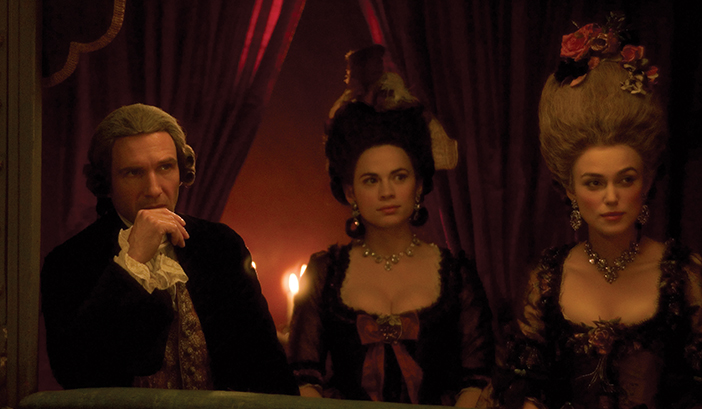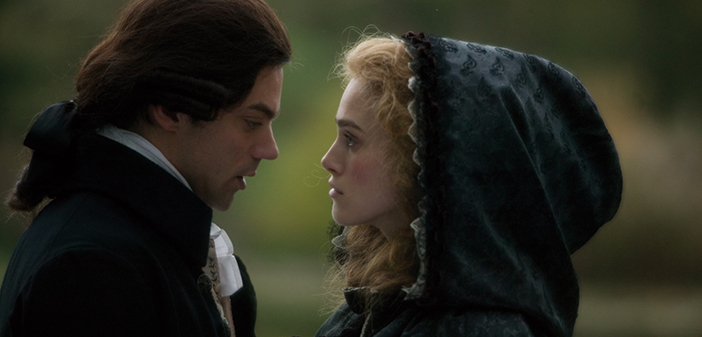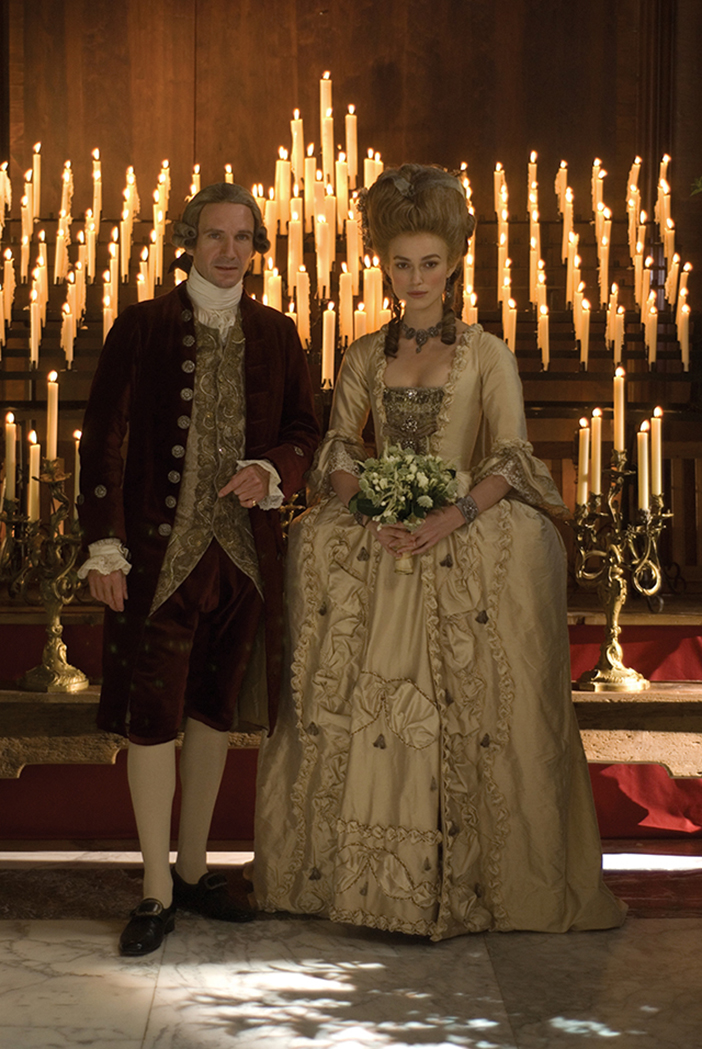The Duchess, starring Keira Knightley in the title role, tells the story of Georgina Spencer nee the Duchess of Devonshire, one of the eighteenth century’s most celebrated society figures. The film is an adaptation of the acclaimed biography by Amanda Foreman and aims to give a dramatised but historically truthful account of a high-rolling aristocratic lady famous for her beauty, her brilliant but unhappy marriage, her style, her political activism and her love of gambling. It is a life that has all the ingredients for an engrossing cinematic experience – intriguing characters, an exciting period of history in the late eighteenth century and plenty of romance. Indeed, it is surprising that the Duchess of Devonshire has only been portrayed twice previously on the big screen – by Evelyn Hall in ‘The Divine Lady’ from 1929 and Mary Clare in the 1947 film ‘Mrs Fitzherbert’. And, as a relation of the most famous Spencer of all, Lady Diana Spencer, her story has a compelling contemporary connection, which, rather ironically, has caused a little controversy between the leading lady and the marketing department which decided to utilise the Spencer connection in its promotional campaign. Knightley never had Princess Diana in mind during the shoot: “I was only eleven when Diana died, so I don’t really know much about her story. It didn’t even occur to me to portray Georgiana as Diana, as I wasn’t conscious of the similarities, and nobody suggested I should. I was always Georgiana, never Diana.”

The parallel is, to a degree, reasonable, as indeed are others, but Amanda Foreman agreed with Knightley that the film trailers had been overdone. Still, in her opinion Georgiana was “in a sense, a cross between Marilyn Monroe and Lady Diana. She was star and a celebrity but she was also an immensely tragic figure, incredibly shy inside, but desperately seeking attention. Like these other women, she was trying to define herself while all the men around her, especially in the press, were trying to define her in ways that she didn’t recognize. One of the aspects of Georgiana’s life that makes it so relevant today is that she had to live through all of these events under the intense glare of public scrutiny.” Georgiana was born on June 7, 1757, the first of five children born to John Spencer, the 1st Earl Spencer (December 19, 1734 – October 31, 1783). Spencer was a Whig MP for Warwick from 1756 to 1761. He was also High Steward of St Albans in 1772 and Mayor of St Albans in 1779. On April 3, 1761, he was created 1st Baron Spencer of Althorp and 1st Viscount Spencer. On November 1, 1765, he was created 1st Viscount Althorp and 1st Earl Spencer. He died in 1783, aged 48, and was buried at Great Brington, Northamptonshire. Born into the high-aristocracy Georgiana’s purpose in life was determined whilst she was a child when she was betrothed to William Cavendish, 5th Duke of Devonshire, whom she married at the age of seventeen. He was almost ten years her senior but it was not the age difference that made the marriage an unhappy one – the Duke, for reasons that can only be surmised as little is known about an enigmatic and rather opaque character, had little passion for his beautiful young wife, although they managed to have three children together.

How Georgina’s life parallels that of Diana Spencer has relevance, but her character arguably bears a closer resemblance to another fiery aristocratic woman who lived a century later – Daisy, Countess of Warwick, King Edward VII’s favourite mistress, society beauty and a political activist who became something of a left-wing firebrand. Both Georgiana and Daisy endured failed marriages and both lost their husband to the ‘other woman’. Out of personal unhappiness came an independence born of high-spirits and in both cases a driving need to assert themselves in a male dominated world. Both chose the path of progressive politics – Daisy moved from liberalism to socialism; Georgiana sided with the Whigs, who represented the progressive trend of the day grouped around the banner of constitutional monarchy. Of course, Diana Spencer too had similar experiences and found her compassion led her to politics, most memorably through her anti-landmines campaign. For Georgiana politics and the personal mixed through her relationship with the leading Whig politician Charles Grey. Having tolerated a menage a trois in her own marriage with the Duke’s long term relationship with Lady Elizabeth Foster, the daughter of Frederick Hervey, Earl of Bristol, Georgiana embarked on a love affair with Grey and they had a child together, Eliza (an ancestor of Sarah, Duchess of York). Georgiana and Elizabeth had been best friends until the affair. After Georgiana’s death in 1806, Elizabeth became the second Duchess of Devonshire. It is a tale replete with historic resonances, but it was still up to the director and his cast to bring it all to life on the big screen. To capture this world – “the last hurrah of the great aristocrats” – director Saul Dibb recruited an artistic team that includes Hungarian-born cinematographer Gyula Pados, production designer Michael Carlin and costume designer Michael O’Connor. With this crew, Dibb sought to forge a mix of authentic locations and vibrantly modern filmmaking style. The decision was made early on not to create soundstage sets, but rather to shoot in real historical houses to create a more naturalistic feeling that defies the period setting. Ultimately, a number of magnificent 18th Century country houses were used to reconstruct the Devonshire houses and other sets, including Kedleston Hall in Derbyshire; the Bristol Old Vic theatre; the Bath Assembly Rooms; Holkham Hall in Norfolk; Osterley Park; Greenwich Naval College and Somerset House in London. The production also shot at the massive Chatsworth House, the authentic seat of the Dukes of Devonshire, where Georgiana Spencer and William Cavendish once roamed the halls. The biggest challenge of all the locations was to re-create Devonshire House, the Duke and Duchess’ main London residence, which is no longer in existence. This involved combining rooms at Kedleston and Holkham Halls for the interiors, while the exterior was shot at Somerset House in London. Explains Dibb: “Devonshire House was known as this big, austere, slightly prison-like fortress and the best way to re-create that was to put together a few houses. The first is Kedleston Hall which has an extraordinary ballroom and a particular kind of look, and we put that with Holkham Hall in Norfolk. Although they are by different architects the style is the same, so we were able to create this austere, but beautiful bachelor pad for the Duke. It was a very specific look.”

That search for authenticity was shared by the cast. Keira Knightley turned to the historical record to find her character. Once Knightley had read both the script and Amanda Foreman’s book, she simply could not resist the character of the Duchess: “She’s a wonderfully strong female role, an extraordinary and very alive woman, and I think any actress would relish playing Georgiana. She’s a dreamer and an idealist who is suddenly stuck in a marriage with a husband who is the very opposite of that. The Duke is someone who shows no emotions. Georgiana is an incredibly emotional, passionate woman, and it seems there’s no clear way out of this complicated relationship. But, for everything Georgiana goes through, she actually finds a way to eventually triumph over things and regain power in a time when women had so little.” Diving deeply into the role, Knightley pored through the Duchess’ preserved letters and analyzed the numerous famous portraits of Georgiana from the period. The more she learned, the more she became fascinated by the great gap between Georgiana’s private and public lives: “What’s interesting is that the less attention she gets from her husband, the more she craves attention from the entire world. I think a part of her loved being the center of attention, having her every move commented upon, but then it turned quite nasty.” She was also intrigued by Georgiana’s deep involvement in the politics of the day – a reality which shatters the passive image of 18th century women: “I think Georgiana is one of the first examples of a women using celebrity for political gain. She knew if she threw a party or turned up at a rally, there would be people writing about it and gossiping about it. It’s quite fascinating because you can draw huge links to today’s celebrity culture, which we think is a modern phenomenon, yet it was actually going on in the 1780s.” The twenty-three year-old actress gives an accomplished performance, belying her youth and confirming the reason for her already impressive career credits which have confirmed her as a major star and, reportedly, made her the second highest paid actress in Hollywood after Cameron Diaz. Portraying the Duke of Devonshire gave Ralph Fiennes a different challenge as there is little known about Cavendish beyond his public life, as Saul Dibb explains: “The Duke could very easily have become a two-dimensional character. He could have become a cartoon villain of repressed aristocratic male Englishness and when I sent the script to Ralph that was his big worry. But we talked about how we weren’t going to go for all the obvious things, how there would be the freedom to try and understand this man, and who he was beyond this kind of enigmatic figure, and that interested him. With Ralph, we knew he would avoid going for the obvious in every scene and every choice he made would be about making the character and performance more subtle and more layered.” Fiennes saw Cavendish “as emotionally constipated, rather cold, unemotional and quite cruel, but he’s a man of his time. So there are certain values that he holds to, and we have to understand those values and not pre-judge them, which I thought was a good starting point. I thought this is a man who probably does feel quite deeply down somewhere, but he’s holding on to a code of behaviour and belief that he sees as important. It’s very easy to box him in and label him but I think my job playing him was to see him through the values of his own time and play that quite strongly.” Like Knightley, Fiennes did his research, although there was far less to be read about the Duke, history having largely reduced him to a footnote in her story. The director saw his leading man take his own route into the character: “You would go into Ralph’s trailer and there would only be pictures of 18th Century dukes on the wall and he would only be listening to music from the period and I think that really helped him to reflect what it was like to live then.” The reviews of The Duchess confirm that the cast and crew’s efforts have been worthwhile, praising it for a gritty and realistic portrayal of life in eighteenth century Britain, a time when class and reputation defined the person; whilst Keira Knightley’s portrayal of the heroine has been hailed as her best performance yet. (Royalty Magazine Vol. 21/03)


